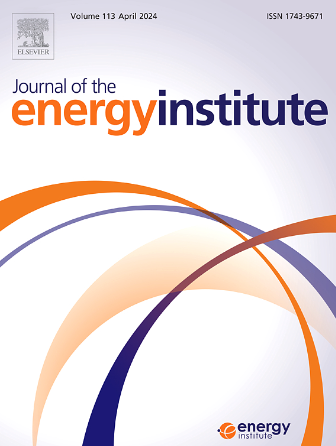Blowout and stability limits of ammonia-hydrogen-nitrogen/air flames in non-premixed coaxial swirl combustor with varying ammonia fraction
IF 5.6
2区 工程技术
Q2 ENERGY & FUELS
引用次数: 0
Abstract
The present experimental investigation concerns identification of stable flame regimes and blowout limits of ammonia-hydrogen-nitrogen flames in confined coaxial swirling jet configuration with a confinement ratio () of 1.82. Volumetric fraction of ammonia is varied from 20 to 70 %. Methane flames are also tested as benchmark case. Flames are imaged using CCD camera fitted with bandpass filters. The binarized Abel-deconvoluted ∗ and ∗ chemiluminescence images are analysed to classify different flame shape transitions. In the non-premixed coaxial swirl combustor, it is observed that ammonia-hydrogen-nitrogen/air flame with 70 % ammonia behaved similar to methane which is in-line with past studies. The blowout limits and time-averaged flame topological transitions as swirl number was systematically varied were also similar. However, 70 % ammonia blend produced compact flames than that of methane. Also, the lift-off height was shorter. As the ammonia fraction decreases (accompanied by consequent increase in hydrogen fraction in the fuel) the blowout limits increase indicating that a stronger swirling strength of coaxial jet is required to blowout ammonia-lean (or hydrogen-rich) fuel. The flame transition zones also widen. The flames become more compact. All in all, ammonia-hydrogen-nitrogen flames with less than 60 % ammonia fraction behave differently when compared to 70 % ammonia fraction fuel and methane. Lastly, a Reynolds number defined based on velocity characterized by strength of coflow swirl jet is shown to vary linearly with fuel Reynolds number for all the fuels. Finally, an expression involving this Reynolds number is proposed as blowout criteria for ammonia-hydrogen-nitrogen flames within the ammonia fractions tested in the present study.
求助全文
约1分钟内获得全文
求助全文
来源期刊

Journal of The Energy Institute
工程技术-能源与燃料
CiteScore
10.60
自引率
5.30%
发文量
166
审稿时长
16 days
期刊介绍:
The Journal of the Energy Institute provides peer reviewed coverage of original high quality research on energy, engineering and technology.The coverage is broad and the main areas of interest include:
Combustion engineering and associated technologies; process heating; power generation; engines and propulsion; emissions and environmental pollution control; clean coal technologies; carbon abatement technologies
Emissions and environmental pollution control; safety and hazards;
Clean coal technologies; carbon abatement technologies, including carbon capture and storage, CCS;
Petroleum engineering and fuel quality, including storage and transport
Alternative energy sources; biomass utilisation and biomass conversion technologies; energy from waste, incineration and recycling
Energy conversion, energy recovery and energy efficiency; space heating, fuel cells, heat pumps and cooling systems
Energy storage
The journal''s coverage reflects changes in energy technology that result from the transition to more efficient energy production and end use together with reduced carbon emission.
 求助内容:
求助内容: 应助结果提醒方式:
应助结果提醒方式:


